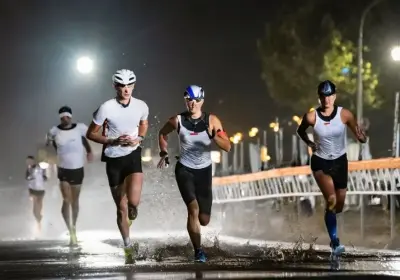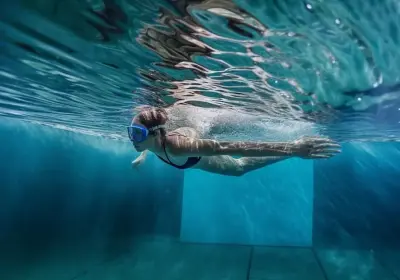Stretching for triathlon training

- 1. Understanding The Importance of Stretching For Triathlon Training
- - The Role of Flexibility in Triathlon Training
- - Improving Performance through Stretching
- - Injury Prevention and Recovery
- 2. Essential Stretching Techniques for Triathletes
- - Dynamic Stretching for Pre-Workout Warm-Up
- - Static Stretching for Recovery and Relaxation
- - Strengthening and Lengthening Key Muscle Groups
- - Breathing and Stretching: Maximizing Effectiveness
- 3. How to Stretch Effectively for Swimming, Cycling, and Running
- - Best Stretches for Swim Muscles
- - Top Cycling Stretches to Boost Performance
- - Crucial Stretches for the Run Leg
- 4. Creating a Stretching Routine for Triathlon Training
- - Incorporating Stretching into Your Training Plan
- - Guidelines for How Often and for How Long to Stretch
- - Designing a Stretching Plan based on Training Intensity and Volume
- 5. Common Mistake and Misconceptions about Stretching in Triathlon Training
- - Overstretching and How to Avoid It
- - Understanding the Right Time to Stretch
- - Debunking Myths about Stretching & Triathlons
- 6. Turn Stretching into a Habit: Motivation Tips for Triathletes
1. Understanding The Importance of Stretching For Triathlon Training
Triathlons are some of the most demanding physical events out there. The optimisation of performance, injury prevention, and accelerated recovery is vitally dependent on one commonly overlooked factor - stretching. Regular, targeted stretches not only induce suppleness in your muscles but they also provide an invaluable boost to your functional mobility. The importance of stretching is underscored by its twofold benefit - it significantly amplifies your performance while concurrently reducing the risk of injuries. Stretching primes your muscles for the exertion to come, bolstering your endurance and resilience. Irrespective of the discipline - be it swimming, cycling, or running - the correct stretching routine truly holds the key to acing your triathlon training.
- The Role of Flexibility in Triathlon Training
The role of flexibility in triathlon training is often undervalued but is, in fact, an essential part of building endurance and performance. Triathlon events demand a lot of physicality, often leading to muscle strains if the body lacks proper flexibility. Flexibility promotes a more fluid range of motion, enabling athletes to handle strenuous activities, such as a long-distance run or a grueling swim, in a more manageable, less strained way. Imagine running a marathon with stiff, unyielding muscles - sounds like a recipe for disaster, doesn't it? This is where flexibility steps in. Increased flexibility doesn't just aid in the prevention of injuries; it also substantially contributes to performance enhancement. By ensuring the muscles and joints are well-stretched and flexible, a triathlete can optimize their reach, stride, and swim stroke, improving overall efficiency. Moreover, it provides a beneficial edge in transitioning between disciplines that require different muscle groups. Hence, while power and endurance hold their places of honor in the holy grail of triathlon training, let's not forget the silent facilitator - flexibility. It certainly deserves its rightful place in the triathlon training regime. Now, isn't that a good reason to incorporate more of those stretches in your workout plan?
- Improving Performance through Stretching
Improving performance in triathlon training is greatly influenced by incorporating a consistent stretching routine. A tighter muscle means a shorter stride, a slower pace, and a higher risk of injury. With triathlon requiring the utilization of varied muscles during its three disciplines - swimming, cycling and running, stretching has a significant role to play. It enhances overall movement efficiency, helping you maintain an optimal posture while minimizing energy waste. Flexibility gained from regular stretching allows an athlete to move a joint through its entire range of motion efficiently, which directly impacts all three disciplines of a triathlon. In swimming, it helps improve stroke length; in biking, it improves posture to reduce air resistance; and in running, it increases stride length. Thus, an increased range of motion attained through regular stretching aids in enhancing the performance by facilitating optimum biomechanics during each discipline. Regular stretching before and after training also helps expedite muscle recovery by fostering better blood circulation, preventing injuries, and promoting faster healing post-training or competition. So, as a triathlete, if you're not currently stretching, then you're missing a crucial component in boosting your performance.
- Injury Prevention and Recovery
Injury prevention and recovery is a critical aspect of triathlon training, and it's here that stretching plays a pivotal role. As a triathlete, your body is often put under intense strains, resulting in the potential build up of lactic acid and higher risk of muscle injuries. Regular, targeted stretching can help prevent this, allowing you to train more effectively and reach your peak performance levels. It does this by increasing flexibility, allowing your muscles to operate at their maximum potential and reducing the risk of pulls and sprains. Moreover, in the unfortunate event of a muscle strain or injury, a well-managed stretching regime can significantly speed recovery. It helps to increase blood flow, which in turn expedites the healing process, helping you get back on track faster. Always remember: a proactive approach to stretching not only staves off injuries but also plays a vital role in recovery. Getting injured is unsettling, right? But, once you delve into the benefits of stretching, you will appreciate the intricate tie it has with injury prevention and recovery. And hey, who doesn't want a smoother, more rewarding path to their triathlon goals? Let's get those muscles flexible and resilient through consistent, effective stretching. Believe me when I say, it's an investment in your athletic journey you won't regret!
2. Essential Stretching Techniques for Triathletes
Stretching is an integral part of training, and for triathletes, it's no different. The sports they dabble in - swimming, cycling, and running - require extreme physical prowess. Understandably, this can become a taxing ordeal on the body. Incorporating a blend of dynamic and static stretches can be effective in conditioning the body for the strenuous physical demands of a triathlon. Dynamic stretches, often used as a warm-up, prompt the muscles and prepare them for the workout, improving mobility and performance. Static stretches, on the other hand, are great for cool-downs as they help the muscles relax, recover, and increase flexibility. Developing a focused stretching routine helps you maintain your muscles in prime condition, fostering strength, dexterity, and endurance. This makes you more resilient and less prone to injuries while enhancing your triathlon performance. Plus, synchronized breathing augments the effectiveness of each stretch, accelerating recovery, and promoting overall well-being. Breathing right can indeed make a world of difference to your stretching regime!
- Dynamic Stretching for Pre-Workout Warm-Up
The role of dynamic stretching in gearing up for your pre-workout routine is significant when it comes to triathlon training. This type of stretching, as opposed to static stretching, comprises of controlled movements that prepare your muscles, ligaments and other soft tissues for performance and safety. It's like giving your body a proper heads-up before you jump into intense training, which not only enhances your body's flexibility but also increases the blood circulation. Take an example of leg swings - a simple yet effective dynamic stretch to loosen up the hips and legs. These swings require you to move your leg back and forth, triggering the hip flexors and extensors, consequential for running and biking. Similarly, arm swings can be a game-changer for your swimming routine, encouraging shoulder mobility and warding off potential injury risk. Your dynamic warm-up, however, should have a balanced synchronization with your training intensity. An overly strenuous stretch isn't beneficial and can lead to unwanted strains. Remember, every strong stride in your triathlon journey begins with a proper warm-up and dynamic stretching is that perfect ignition for your triumphant triathlon training course. Start your journey right - stretch, train, conquer.
- Static Stretching for Recovery and Relaxation
Static stretching plays a vital role for triathletes in terms of recovery and relaxation. When performed after an intense workout, it helps your body to calm down, promoting muscle recovery and reducing post-training stiffness. Focusing on key muscle groups used during triathlon events, such as the hamstrings, lower back, shoulders, and hips, can notably enhance your flexibility and range of motion. It's important to take this part of your training just as seriously as the swim, bike, or run. As an athlete, it's crucial to understand that static stretching shouldn't be rushed. Instead, it's about holding a comfortable stretch for around 20 to 30 seconds while focusing on deep, even breaths. This will encourage your muscles to relax, release tension, and ultimately increase their flexibility. Plus, it can be a great way to wind down mentally too, allowing for some quiet, focused time after the rush of a triathlon training session. Don't forget that every athlete's body is different; hence, personalize your static stretching routine according to your needs. One might require more focus on their calf muscles, while others might need to concentrate more on their shoulder flexibility. Remember, a little extra time on quality stretching can go a long way in your triathlon journey. It’s not just about recovery, it's about enhancing overall performance.
- Strengthening and Lengthening Key Muscle Groups
In the world of triathlon training, strengthening and lengthening key muscle groups is a primary concern. A strong set of muscles, particularly the ones frequently utilized in triathlons, can remarkably enhance your performance and efficiency. At the same time, lengthened muscles are typically more resilient to injuries, enabling you to train more regularly and effectively. A triathlete's muscle armor consists primarily of the core, legs, arms, and shoulders. Specifically, your glutes, hamstrings, quads, hip flexors, calves, rotator cuffs, lats, and triceps will play a significant role in your performance. Strengthening these muscles involves full-body resistance training and weight lifting, which must be balanced with activities that lengthen the muscle fibres, promoting flexibility and range of motion. The latter can be achieved with a range of static and dynamic stretching techniques. Yoga and Pilates are also excellent for both muscle strengthening and lengthening, offering balanced workout regimes for triathletes. No matter the chosen method, consistency is paramount – a regular routine of stretching and strengthening will ensure your muscles are in top shape for your triathlon challenges. So, why wait? It's time to start stretching and strengthening those key muscle groups today!
- Breathing and Stretching: Maximizing Effectiveness
Sure, let's begin: Breathing and Stretching: Maximizing Effectiveness If you're wondering how to take your triathlon training up a notch, consider honing your breathing and stretching techniques. This duo functions like a well-oiled machine, helping to elevate your game to an outstanding level. The power of deep, synchronized breathing while stretching is often underestimated. However, it can augment the effectiveness of your stretches by allowing more oxygen to flood into your muscles, enhancing their flexibility and strength. See, your breath carries a natural rhythm, one that your body is fine-tuned to. Aligning that rhythm with your stretches enables an invigorating exchange of oxygen and carbon dioxide within your muscles. As you inhale, oxygen enters your bloodstream. As you exhale, that oxygen nourishes your muscle tissues, transporting essential nutrients they need to maintain elasticity and efficiency. So, when you bend down in a forward fold or reach up in a muscle-stretching lunge, remember to breathe. Align each stretch with a slow, deliberate inhale or exhale. You'll find your body tuning into this rhythm, and your stretches becoming more productive than ever. It's all about creating a harmony between your mind, body, and breath - one that will undoubtedly resonate within your triathlon performance. Incorporating this simple, yet effective addition into your routine has the potential to transform not just your training, but also your overall endurance and resilience. Remember, it's not just about pushing harder; it's about training smarter, and breathing effectively while stretching is a brilliant step towards that.
3. How to Stretch Effectively for Swimming, Cycling, and Running
Understanding how to stretch effectively for swimming, cycling, and running is paramount for triathletes seeking to improve performance and reduce injury risk. For swimmers, shoulder stretches are essential to maintain a smooth, fluid stroke. Cyclists can greatly benefit from hamstring and hip flexor stretches to alleviate the strain from constant pedaling. As for the runners, calf and quadricep stretches can prevent debilitating cramps, ensuring a strong finish to a demanding race. Tailoring your stretching routines to the specific demands of triathlon disciplines not only enhances performance but also ensures a well-rounded training approach. So, why not start incorporating these stretches into your routine today?
- Best Stretches for Swim Muscles
As an integral part of triathlon training, focusing on the best stretches for swim muscles cannot be overstated in its importance. Swimming requires a unique interplay of muscles, calling into action your shoulders, back, hips, and legs. Regularly incorporating a specific set of stretches can significantly enhance your swimming performance and reduce the risk of injury. One of the most beneficial stretches for swimmers is the shoulder stretch. Just hold your right arm straight across your chest, use your left hand to pull it closer, hold it for 20 to 30 seconds, then switch sides. This stretch will help to keep your shoulders limber and ready for those powerful strokes in the water. The tricep and latissimus dorsi stretch is another gem, which involves reaching upwards and bending your elbow so that your hand touches your opposite shoulder blade, then using your other hand to deepen the stretch. Remember to breathe deeply and hold for about 30 seconds before switching sides. The hip flexor stretch is vital, especially for the flutter kick. Kneel on one knee and push your hips forward, ensuring to keep your back straight. Proper flexibility in your swimming muscles stipulates how effectively you can train and compete. So, never neglect these stretches in your routine! Remember, consistency is key to improving performance and prepping your body for what triathlon training places on it.
- Top Cycling Stretches to Boost Performance
Cycling is a core component in triathlon training that places unique demands on the body. To take your performance to the next level, incorporating top cycling stretches in your routine is key. A cardinal stretch involves the hip flexors and quads - muscles that are heavily engaged during cycling. Start by kneeling on one knee and reach for the back foot of your raised leg, all the while maintaining an upright posture. Hold this stretch for about 30 seconds and switch sides. Another beneficial stretch targets the glutes and lower back. Sit on a mat, cross one leg over the other knee and gently lean forward, keeping your back straight. Aim to hold for at least 30 seconds on each side. Lastly, don't forget about the calves. Stand near a wall, extend one leg backward, heel on the ground, and lean forward until a stretch is felt in your calf. Remember, consistency is paramount in seeing overall improvements. Cycling stretches aren't a one-time magic solution, but with regular practice, they can substantially enhance your performance and prevent injuries. Incorporating these stretches into your routine represents a smart and effective way to boost your cycling prowess in triathlon training.
- Crucial Stretches for the Run Leg
Ensuring that your leg muscles are adequately stretched is a crucial element in triathlon training, particularly when it comes to the run leg of the race. **Dynamic stretches**, such as high knees, lunges, and butt kicks, can prepare your muscles for the rigorous demand of running in a triathlon. By making these exercises part of your warm-up, you can ensure optimal muscle function when it's time to hit the pavement, thus **reducing the risk of injuries**. Additionally, **static stretches** aimed at the hamstrings, calves, and hip flexors can be invaluable when it comes to recovery post-run. Long hold stretches such as the butterfly stretch, calf stretch, and standing quadricep stretch facilitate improved flexibility and help lengthen muscles that tend to tighten during intense training. Breathing deeply as you stretch allows for better oxygen flow to the muscles and aids in speedier recovery. Remember that stretching should not be painful; **comfort is key**. Progress over perfection should be your guiding mantra. Easing into these stretches gradually and making them a regular part of your **training routine** can be a significant game-changer in your overall running performance in a triathlon. So, why not start today? Your muscles will thank you.
4. Creating a Stretching Routine for Triathlon Training
Creating a stretching routine for triathlon training is a vital step in aligning your body for the grueling physical demands. It helps to increase the performance potential and ultimately leads to better race times. Personalizing your stretching routine is key - yes, you heard that right! It's not all about copying the stretches your idol does, but focusing on what your body primarily needs. Pay attention to muscle groups that often feel tense or fatigued. Start with dynamic stretches to prep your body before workouts, and don’t skip out on static stretches post-training. Make stretching a non-negotiable part of your day, just like brushing your teeth!
- Incorporating Stretching into Your Training Plan
Incorporating stretching into your triathlon training plan is an integral aspect that quite often, tends to be overlooked. You might question, "Why is stretching so pivotal?" Well, the answer lies in the simple fact that stretching aids in preparing your body for the strain of intense training, reducing the risk of injuries. In addition to this, it enhances performance by increasing flexibility, coordination, and range of motion. So, how can you meticulously incorporate stretching into your routine? The key is consistency and balance. Start with incorporating a quick 5 to 10 minutes of dynamic stretching before your training sessions. This acts as an essential warm-up, preparing your muscles for the workout ahead. Post-training, spend at least 15 minutes on static stretching to help with muscle recovery and reducing soreness. Remember, it's not about hurrying through a routine. Focus on each stretch, embracing the tension and release in your muscles. Moreover, ensure that you are stretching all the relevant muscle groups related to your triathlon training; from your shoulders for your swim, your thighs and calves for your cycle, to your hamstring and hips for your run. With consistent effort, this simple habit of incorporating stretching into your training regime will pay rich dividends in your overall performance. It’s time to stretch your way to success!
- Guidelines for How Often and for How Long to Stretch
When it comes to incorporating stretching into your triathlon training plan, figuring out how often and how long to stretch is crucial in ensuring effective results. Generally, a consistent routine is key to improvement, so committing to a daily stretching routine would give you the best outcome. Minimum stretching should be done at least 3-4 times per week, preferably after workouts. Notably, how long you stretch comes down to your individual goals and comfort levels. However, a good rule of thumb is to hold static stretches for about 30 seconds each. Long enough to allow your muscles to relax and lengthen. For dynamic stretches, aim for approximately 10-12 repetitions per movement to warm up effectively. Keep in mind, though, stretching sessions shouldn’t be marathons. Spending 15-20 minutes at a time on focused, effective stretching is typically sufficient for most triathletes. Remember, the quality of each stretch and focusing on proper techniques matters a lot more than the duration. Just as you wouldn’t rush your swim, bike, or run training, you shouldn’t rush through your stretches either. Finally, always listen to your body. If a stretch feels intensely uncomfortable or painful, it's perhaps a sign you're pushing too hard. A little discomfort is expected, but stretching should never be painful. Training smart includes stretching smart!
- Designing a Stretching Plan based on Training Intensity and Volume
Creating a personalized and effective stretching plan requires careful consideration of both your training intensity and volume. Every individual triathlete's training schedule will differ due to factors like athletic background, training time, and specific triathlon goals. High-intensity workouts commonly associated with triathlon training, such as interval sets or hill repetitions, will require increased emphasis on dynamic stretches pre-workout and deeper, static stretches post-workout. Regularly incorporating these stretch types can enhance muscle flexibility, thereby facilitating better performance and prevention of exercise-induced injuries. When considering training volume, remember that more isn't always better. Recognizing your body's limits and knowing when to rest is crucial. As a triathlete, you are training for three different sports, therefore it's essential to allocate proportions of stretching to each discipline proportionally. For example, if you are swimming with high frequency, shoulder and back stretches should form a substantial part of your routine. Creating a tailored, triathlon-specific stretching plan calls for continual modification as your training evolves. Regular reassessment ensures that your stretching remains maximally effective across all three disciplines. After all, a well-rounded stretching routine is your ticket to enhanced performance, a reduced risk of injuries, and generally improved well-being. So remember, stretching is not just an optional exercise, but is integral to successful triathlon training. With the right plan in place, you can work towards your triathlon goals with strengthened resolve and a body better prepared for the rigorous demands of the sport.
5. Common Mistake and Misconceptions about Stretching in Triathlon Training
Falling prey to common stretching errors in triathlon training is a misstep you can't afford. Overstretching, a pitfall many triathletes unsuspectingly slip into, can lead to injuries and impact your performance negatively. Knowing when to stretch is equally important. Contrary to popular misconception, stretching should not be confined to before or after workouts only. Integrating it throughout your training is a smart way to boost muscle efficiency. Also, let's bust the myth right here - stretching does not necessarily lead to muscle shortening or loss of agility. Instead, appropriate stretching makes your muscles more adaptable for the challenging triathlon training. Get your facts right and avoid these common stretching mistakes for a successful triathlon journey!
- Overstretching and How to Avoid It
In striving to get the most out of their triathlon training, some athletes fall into the potential pitfall of overstretching. This common misstep can lead to injuries that impede progress and thwart performance improvement. However, avoiding it is easier than most would think. Understanding your body's signals is the first and foremost step to prevent overstretching. Incorporating a variety of stretches, rather than obsessively focusing on a single type, also minimizes the risk of injury. Stretching should induce a feeling of 'mild discomfort,' but not pain. If it hurts, it's a clear sign you've gone too far. It's necessary to respect your body’s limits and gradually increase your flexibility. Patience is indeed a virtue in enhancing flexibility safely and effectively. Moreover, proper technique is vital. Rushing through your stretching routine or doing it with incorrect form counters its benefits. Consider seeking advice from a coach or a physical therapist. Remember, stretching isn't a competition; the goal is to boost your performance in the triathlon, not to contort your body beyond its limits. Hence, avoid overstitching, train wisely, and let your body soar to its optimal potential.
- Understanding the Right Time to Stretch
Understanding the right time to stretch in a triathlon training session is crucial, and it often goes misunderstood by many athletes. Stretching should not be perceived as an occasional routine, but rather an integral part of your training regime. It's not about when you have time, but about making time. A common misconception is saving stretching for after your workout only. However, a multitude of research suggests that incorporating dynamic stretching pre-exercise can significantly enhance performance. This type of stretching effectively warms up your muscles, preparing your body for the rigorous activity to come. It allows for better mobility, flexibility, and balance, potentially lessening the risk of injuries during training. Contrarily, static stretching is best performed post-workout, helping the muscles to relax, recover, and grow. Stretching at this time can boost circulation, aiding in the removal of lactic acid and ultimately reducing muscle soreness. Therefore, both before and after exercise, stretching should be prioritized to maximize performance and minimize injury risk. Remember, each workout is a small part of a larger journey to becoming a triumphant triathlete. Prioritizing proper stretching routines based on timing is a giant leap towards achieving that goal.
- Debunking Myths about Stretching & Triathlons
In the realm of triathlon training, there's a fair share of misconceptions surrounding the topic of stretching. Let's bust a few notorious myths right now. Some athletes believe that stretching should cause discomfort - a clear misinterpretation. In reality, stretching should entail a gentle pull, bringing about a sense of elongation, not pain. You're not meant to push your body to its limits here! Another widely held belief is that stretching provokes muscle weakening. In truth, consistent and appropriate stretching results in muscle flexibility improvement, which in turn boosts performance and mitigates injury risks in triathlon training. Additionally, let's debunk the myth that stretching aids in eliminating lactic acid. Scientific studies demonstrate no direct relationship between these two aspects. Finally, some triathletes have the flawed perception that stretching is a time-consuming activity. However, integrating a 5-10 minute focused stretch session in your routine can deliver significant benefits and assist in accomplishing your triathlon goals more efficiently. Remember, every myth can infringe on your training efficiency - always ensure to base your stretching routine on proper knowledge and technique!
6. Turn Stretching into a Habit: Motivation Tips for Triathletes
Transitioning stretching into a consistent habit can drastically enhance your performance as a triathlete. Importantly, consistent stretching offers long-term benefits that go beyond merely boosting your race-day performance. For instance, regular and proper stretching can significantly decrease the risk of injuries and improve your overall flexibility, crucial for swimming, biking, and running effectively. Remember, just as any other training program, success lies in consistency. Transform stretching into a fun regime—perhaps by incorporating music or opting for scenic, outdoor locations like your local park. Furthermore, set achievable stretching goals and track your progress regularly. After all, seeing improvement works as a motivation like nothing else. Isn't it exciting to know that your own body's flexibility has improved over weeks of disciplined training? Dedicate effort to understand how different stretches benefit you, and you could turn this often-overlooked aspect of training into your secret performance-booster. Be the master of your own triathlon story and revel in the power of flexibility!
- The Long-Term Benefits of Regular Stretching
When it comes to triathlon training, we may often undermine the long-term benefits of regular stretching. However, it plays a crucial role in extending athletic longevity. Over time, consistent stretching routines can lead to significant improvements in your range of motion. This not only helps maintain a fluid and efficient technique throughout all triathlon stages but also decreases the risk of injuries. Longevity in the sport isn't just about strength or endurance, it's about how well we take care of our bodies too. Let's not forget the impact on muscle recovery either. After intensive training or race, muscles can become sore and tense. With regular stretching, we can reduce the muscle soreness and accelerate recovery times. It's like giving your body a relaxing treat after all the hard work. But wait, there's more! No matter your age or ability, combining a healthy stretching routine with your triathlon training can significantly boost your performance. Overlooked yet packed with benefits like greater power, speed, and agility; regular stretching could become the secret weapon in your triathlon success. So here's the bottom line—make stretching a regular part of your training routine. Make it a non-negotiable. The benefits are too substantial to ignore. Isn't it time we gave our bodies the care it deserves? Trust me, your future self will thank you!
- Making Stretching a Fun Part of Your Training Regime
Making stretching a fun part of your triathlon training regime isn't as daunting as it seems. First off, it’s crucial to change your mindset about stretching. Don’t consider it a burdensome task but rather as a strong grounding exercise that gives your body the much-needed flexibility and strength to sail through grueling triathlon training. Next, get creative! Set up a stretch routine infused with some enjoyable elements. Ever tried exercising to your favorite upbeat tunes? If not, then it’s high time you did. This simple trick can make your stretch time enjoyable and something you’d look forward to. Besides, you can also try some active video games that incorporate stretching exercises; they're not just fun, but they'll also keep you moving. It's all about breaking the monotony. Another interesting tip is to involve a training partner. This is not only motivating but also adds a fun, communicative element to your regimen. Here, it’s not about who stretches better, but how you both can benefit from strengthening each other's determination. Remember, the key is to make stretching habitual yet not stressful. The more enjoyable you make it, the more likely you’re going to stick with it. So, go on, incorporate some fun into your stretch time, and take your triathlon performance to new heights.
- Setting Up Stretching Goals and Tracking Progress
Establishing stretching goals and monitoring your progress is a fundamental fitness practice that can significantly aid your triathlon training. Crafted right, these objectives can help turn an obligatory stretching regimen into an enriching, motivational aspect of your training. Instead of viewing stretching as a tedious chore, convert it into something you look forward to. Begin with comprehensible, quantifiable aims like improving your range of motion or alleviating muscle tightness. Remember, Rome wasn't built in a day, so don’t anticipate immediate results - changes in flexibility are measured in millimeters, not miles. Consistency is key in this journey towards wellness and enhanced performance. Reflecting on your progress over time can serve as an inspiring lever, pushing you to strive on days you feel uninspired. A promising practice to track your progress is keeping a journal. Document your stretching routines, noting down what you did, how long you stretched, and any changes or improvements you notice. Overlooking these patterns can often lead to stagnation, so it's vital to keep watch and adjust as necessary. Where are you feeling more flexible? Where do you still experience stiffness? By tracking these patterns, you can tailor your stretching routine to target your individual needs, accelerating your triathlon training process and amplifying your capabilities.
In conclusion, incorporating stretching into your triathlon training routine can significantly improve flexibility, boost performance, and prevent injuries. Essential stretching techniques, tailored to each triathlon discipline, help in strengthening and lengthening key muscle groups. Avoid common mistakes and misconceptions about stretching to maximize its benefits. By turning stretching into a habit and setting achievable goals, triathletes can ensure consistent improvement and success in their performance.
What is the importance of stretching for triathlon training?
Flexibility plays a crucial role in triathlon training as it boosts performance, aids in injury prevention and recovery, and enhances overall efficiency and biomechanics in all three disciplines - swimming, biking, and running.
What are some essential stretching techniques for triathletes?
Dynamic stretching for pre-workout warm-up, static stretching for recovery, and focused exercises for strengthening and lengthening key muscle groups are essential. Proper breathing is also critical for maximizing the effectiveness of these stretches.
Which stretches are beneficial for swimming, cycling, and running?
For swimming, shoulder and upper body stretches can be highly beneficial. Hip flexor, quad, and hamstring stretches help improve cycling performance. Runners should focus on the calf, hamstring, and hip muscles.
How do you create a stretching routine for triathlon training?
Integrate a balanced mix of dynamic and static stretches into your routine, based on your training volume and intensity. The guidelines suggest stretching every day and holding each stretch for about 30 seconds to 2 minutes.
What are some common mistakes or misconceptions about stretching in triathlon training?
One common misconception is that you should feel pain during stretching - this is not true. Overstretching can cause injuries. The right time to stretch is after a workout, not before, when the muscles are warmed up.
How can triathletes keep motivated to maintain a consistent stretching routine?
Understanding the long-term benefits of regular stretching, making the process enjoyable, and setting measurable goals can help turn stretching into a habit and keep triathletes motivated.


















































Leave a comment